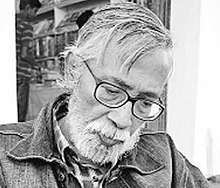Nabarun Bhattacharya
Nabarun Bhattacharya (23 June 1948 – 31 July 2014) was an Indian writer in Bengali language. He was born at Baharampur (Berhampur), West Bengal. He was the only child of actor and playwright Bijon Bhattacharya and writer and activist Mahashweta Devi.[1] His maternal grandfather was the well-known writer from the Kallol era, Manish Ghatak. Visionary filmmaker Ritwik Ghatak was his great uncle.
Nabarun Bhattacharya | |
|---|---|
 | |
| Born | 23 June 1948 Baharampur (Berhampur), West Bengal |
| Died | 31 July 2014 (aged 66) Kolkata, India |
| Occupation | Writer |
| Language | Bengali |
| Alma mater | Calcutta University |
| Notable works | Herbert (1994), "Andho Biral", "Fyataru" |
| Notable awards | Sahitya Akademi Award |
| Relatives | Bijon Bhattacharya (father) Mahashweta Devi (mother) |
His novel, Herbert (1993), was awarded the Sahitya Akademi Award, and adapted into a film of the same name in 2005, by Suman Mukhopadhyay.[2]
Personal life
Bhattacharya studied in Kolkata, first Geology, then English, from Calcutta University.[1] Nabarun married Pranati Bhattacharya, who was a professor of political science.[3]
Works
The characters called Fyataru
His magic realist writings introduced a strange set of human beings to Bengali readers, called Fyataru (fyat: the sound created by kites while they are flown; otherwise, fyat has also a hint of someone worthless, deriving from the words foto, faaltu; uru: related to flying), who are an anarchic underclass fond of sabotage and are capable of flying whenever they utter the mantra 'fyat fyat sh(n)aai sh(n)aai' (This mantra was made into a song by the popular Bangla band Chandrabindoo in one of its albums[4]). They appear in his books Mausoleum, Kaangaal Maalshaat, Fatarur Bombachaak, Fyatarur Kumbhipaak and Mobloge Novel.[5] Suman Mukhopadhyay, who was basically from a theatrical background, dramatized Kangal Malsat.[6]
Major works
- Kangal Malshat (কাঙাল মালসাট) (Hooghly: Saptarshi Prakashan, 2003)
- Herbert (Kolkata: Deys, 1994)
- Lubdhak (Barasat: Abhijan Publishers, 2006)
- Ei Mrityu Upotyoka Aamaar Desh Na (Hooghly: Saptarshi, 2004)
- Halaljhanda o Onyanyo (Hooghly: Saptarshi, 2009)
- Mahajaaner Aayna (Kolkata: Bhashabandhan, 2010)
- Fyaturur Kumbhipak (Kolkata: Bhashabandhan)
- Raater Circus (Kolkata: Bhashabandhan)
- Anarir Naarigyan (Kolkata: Bhashabandhan)
- Joratali (Kolkata: Bhashabandhan, Posthumous)
- Mablage Novel(Kolkata:Bhashabandhan, Posthumous)
Death
Nabarun Bhattacharya died of intestinal cancer at Thakurpukur cancer hospital, Kolkata on 31 July 2014.[7]
References
- Kartik Chandra Dutt, ed. (1999). Who's who of Indian Writers, 1999: A-M. Sahitya Akademi. p. 164. ISBN 81-260-0873-3.
- Nathan Lee (10 December 2008). "Storm Advisory: Cyclone of a Life on the Horizon". New York Times.
- "End of journey for the eternal rebel: Nabarun Bhattacharya passes away". timesofindia.com. Times of India. 1 August 2014. Retrieved 12 March 2017.
- "Hulabila". Archived from the original on 23 September 2017. Retrieved 21 July 2010.
- ""Carnival-er Bisphoron" – Review of Nabarun Bhattacharya's "Kangal Malsat", by Tapodhir Bhattacharya – Parabaas Issue 35". Parabaas.com. Retrieved 6 October 2011.
- "The Telegraph – Calcutta : Metro". Telegraphindia.com. 4 March 2006. Retrieved 6 October 2011.
- "Radical Bengali writer Nabarun Bhattacharya dies at 66 – IBNLive". Ibnlive.in.com. Retrieved 31 July 2014.
External links
- Works by or about Nabarun Bhattacharya at Internet Archive
- "An Indian Writer in Japan : Textualities". Archived from the original on 9 June 2011. Retrieved 20 November 2016.
- American Petromax (Hindi) – Nabarun Bhattacharya